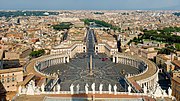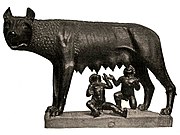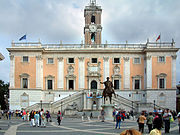Rome (Italian: Roma, Latin: Roma) is the capital city of Italy and of the Lazio region[2], as well as the country's largest and most populous city, with more than 2.7 million residents.[3] The metropolitan area has a population of about 4 million. It is located in the central-western portion of the Italian peninsula, where the river Aniene joins[4] the Tiber.
Rome, Caput mundi (Capital of the world), la Città Eterna (The Eternal City), Limen Apostolorum (Threshold of the Apostles), la città dei sette colli (The city of the seven hills) or simply l'Urbe (The City),[5] has been for centuries the center of Western civilization, and is the seat of the Catholic Church.
The State of the Vatican City, the sovereign territory of the Holy See is an enclave of Rome.
Today, Rome is modern and cosmopolitan, and the third most-visited tourist destination in the EU.[6]
As one of the few major European cities that escaped World War II relatively unscathed, central Rome remains essentially Renaissance and Baroque in character. The Historic Center of Rome is listed by UNESCO as a World Heritage Site.[7]
History

From founding to Empire
According to a legend, the city of Rome was founded by the twins Romulus and Remus[10] on April 21, 753 BC, and archaeological evidence supports the theory that Rome grew from pastoral settlements on the Palatine Hill built in the area of the future Roman Forum, coalescing into a city in the 8th century BC. The city developed into the capital of the Roman Kingdom (ruled by a succession of seven kings, according to tradition), Roman Republic (from 510 BC, governed by the Senate), but finally the Roman Empire (from 27 BC, ruled by an Emperor); this success depended on military conquest, commercial predominance, as well as selective assimilation of neighboring civilizations, most notably the Etruscans and Greeks. From the foundation of Rome in 753 BC, the City of Rome was undefeated militarily (though losing occasional battles), until 386 BC, when Rome was occupied by the Celts (one of the three main Gallic tribes), and then recovered by Romans in the same year. Livy, Book 5. According to the history, the Gauls offered to deliver Rome back to its people for a thousand pounds of gold, but the Romans refused, preferring to take back their city by force of arms rather than ever admitting defeat.
Roman dominance expanded over most of Europe and the shores of the Mediterranean sea, while its population surpassed one million inhabitants. For almost a thousand years, Rome was the most politically important, richest and largest city in the Western world, and remained so after the Empire started to decline and was split, even if it ultimately lost its capital status to Milan and then Ravenna, and was surpassed in prestige by the Eastern capital Constantinople.
Fall of the Empire and Middle Ages
With the reign of Constantine I, the Bishop of Rome gained political as well as religious importance, eventually becoming known as the Pope and establishing Rome as the center of the Catholic Church. After the Sack of Rome in AD 410 by Alaric I and the fall of the Western Roman Empire in AD 476, Rome alternated between Byzantine and plundering by Germanic barbarians. Its population declined to a mere 20,000 during the Early Middle Ages, reducing the sprawling city to groups of inhabited buildings interspersed among large areas of ruins and vegetation. Rome remained nominally part of the Byzantine Empire rule until AD 751 when the Lombards finally abolished the Exarchate of Ravenna. In 756, Pepin the Short gave the pope temporal jurisdiction over Rome and surrounding areas, thus creating the Papal States. Rome remained the capital of the Papal States until its annexation into the Kingdom of Italy in 1870; the city became a major pilgrimage site during the Middle Ages and the focus of struggles between the Papacy and the Holy Roman Empire starting with Charlemagne, who was crowned its first emperor in Rome on Christmas 800 AD by Pope Leo III. Apart from brief periods as an independent city during the Middle Ages, Rome kept its status of Papal capital and "holy city" for centuries, even when the Pope briefly relocated to Avignon (1309–1337). While no longer politically powerful, as tragically shown by the brutal sack of 1527, the city flourished as a hub of cultural and artistic activity during the Renaissance and the Baroque, under the patronage of the Papal court.
17–19th century
Population rose again and reached 100,000 during the 17th century, but Rome ultimately lagged behind the rest of the European capitals over the subsequent centuries, being largely busy in the Counter-Reformation process. Caught up in the nationalistic turmoils of the 19th century and having twice gained and lost a short-lived independence, Rome became the focus of the hopes for Italian unification, as propelled by the Kingdom of Italy ruled by King Vittorio Emanuele II; after the French protection was lifted in 1870, royal troops stormed the city, and Rome was declared capital of the newly unified Italy in 1871.
20th century
After a victorious World War I, Rome witnessed the rise to power of Italian fascism guided by Benito Mussolini, who marched on the city in 1922, eventually declared a new Empire and allied Italy with Nazi Germany. This was a period of rapid growth in population, from the 212,000 people at the time of unification to more than 1,000,000, but this trend was halted by World War II, during which Rome was damaged by both Allied forces bombing and Nazi occupation; after the execution of Mussolini and the end of the war, a 1946 referendum abolished the monarchy in favor of the Italian Republic. Rome grew momentously after the war, as one of the driving forces behind the "Italian economic miracle" of post-war reconstruction and modernization. It became a fashionable city in the 1950s and early 1960s, the years of la dolce vita ("the sweet life"), and a new rising trend in population continued till the mid-1980s, when the comune had more than 2,800,000 residents; after that, population started to slowly decline as more residents moved to nearby comuni; this has been attributed to their perceiving a decrease in the quality of life,[citation needed] especially because of the continuously jammed traffic and the worsening pollution it brings about. In recent years the trend has changed again and the population is increasing again, thanks also to the cultural and economic dynamism of the city and immigration from many different countries.
Architecture, landmarks and city layouts


Ancient Rome
One of the symbols of Rome is the Colosseum (70-80 AD), the largest amphitheatre ever built in the Roman Empire. Originally capable of seating 60,000 spectators, it was used for gladiatorial combat. The list of the very important monuments of ancient Rome includes the Roman Forum, the Domus Aurea, the Pantheon, Trajan's Column, Trajan's Market, the several catacombs area, the Circus Maximus, the Baths of Caracalla, Castel Sant'Angelo, the Mausoleum of Augustus, the Ara Pacis, the Arch of Constantine, the Pyramid of Cestius, and the Bocca della Verità.
Medieval
- See also: Medieval architecture
Often overlooked, Rome's medieval heritage is one of the largest in Italian cities. Basilicas dating from the Paleochristian age include Santa Maria Maggiore and San Paolo Fuori le Mura (the second largely rebuilt in the 19th century), both housing precious 4th century AD mosaics. Later notable medieval mosaic and fresco art can be also found in the churches of Santa Maria in Trastevere, Santi Quattro Coronati and Santa Prassede. Lay buildings include a number of towers, the largest being the Torre delle Milizie and the Torre dei Conti, both next the Roman Forum, and the huge staircase leading to the basilica of Santa Maria in Ara Coeli.
Renaissance and Baroque
- See also: Renaissance architecture
- See also: Baroque architecture
Rome was a major world center of the Renaissance, second only to Florence, and was profoundly affected by the movement. The most impressive masterpiece of Renaissance architecture in Rome is the Piazza del Campidoglio by Michelangelo, along with the Palazzo Senatorio, seat of the city government. During this period, the great aristocratic families of Rome used to build opulent dwellings as the Palazzo del Quirinale (now seat of the President of the Republic), the Palazzo Venezia, the Palazzo Farnese, the Palazzo Barberini, the Palazzo Chigi (now seat of the Prime Minister), the Palazzo Spada, the Palazzo della Cancelleria, and the Villa Farnesina.
Rome is also famous for her huge and majestic squares (often adorned with obelisks), many of which were built in the 17th century. The principal squares are Piazza Navona, Piazza di Spagna, Campo de' Fiori, Piazza Venezia, Piazza Farnese and Piazza della Minerva. One of the most emblematic examples of the baroque art is the Fontana di Trevi by Nicola Salvi. Other notable baroque palaces of 17th century are the Palazzo Madama, now seat of the Italian Senate and the Palazzo Montecitorio, now seat of the Chamber of Deputies of Italy.
Neoclassicism
- See also: Neoclassical architecture
In 1870, Rome became capital city of the new Kingdom of Italy. During this time, neoclassicism, a building style influenced by the architecture of Antiquity, became a predominant influence in Roman architecture. In this period many great palaces in neoclassical styles were built to host ministries, embassies and other governing agencies. One of the best-known symbol of Roman neoclassicism is the Monument of Vittorio Emanuele II or "Altar of Fatherland", where the grave of the Unknown Soldier, that represents the 650,000 Italians that fell in World War I, is located.
Fascist architecture
- See also: Fascist architecture
The Fascist regime that ruled in Italy between 1922 and 1943 developed an architectural style which was characterized by its linkages with ancient Rome architecture. The most important fascist site in Rome is the E.U.R. district, built in 1935. It was originally conceived for the 1942 world exhibition, and was called "E.42" ("Esposizione 42"). However, the world exhibition never took place because Italy entered the Second World War in 1940. The most representative building of the Fascist style at E.U.R. is the Palazzo della Civiltà Italiana (1938-1943), the iconic design of which has been labeled the cubic or Square Colosseum. After World War II, the Roman authorities found that they already had the seed of an off-centre business district that other capitals were still planning (London Docklands and La Defense in Paris). Also the Palazzo della Farnesina, the actual seat of Italian Foreign Ministry, was designed in 1935 in fascist style.
City centre
The historical centre ville is dominated by the traditional "Seven hills of Rome": the Capitoline, Palatine, Viminal, Quirinal, Esquiline, Caelian, and Aventine hills. The Tiber flows south through Rome, with the city centre located where the midstream Tiber Island facilitated crossing. Large parts of the ancient city walls remain. The Servian Wall was built twelve years after Gauls' sack of the city in 390 BC; it contained most of the Esquiline and Caelian hills, as well as the whole of the other five. Rome grew out of the Servian Wall, but no more walls were constructed until 270 AD, when Aurelian began building the Aurelian Walls. These were almost twelve miles (19 km) long, and were still the walls the troops of the Kingdom of Italy had to breach to enter the city in 1870.
The old city center contains about 300 hotels and 300 pensioni, over 200 palaces, 900 churches, eight of Rome's major parks, the residence of the President of the Italian Republic, the houses of the Parliament, offices of the city and city government, and many monuments. The old city also contains thousands of workshops, offices, bars, and restaurants. Millions of tourists visit Rome annually, making it one of the most visited cities in the world.
Peripheral layout
The ancient city within the walls covers about four percent of the modern municipality's 1,285 square kilometres (496 sq mi). The historic city center is the smallest of Rome's nineteen administrative zones. The city center is made up of 22 rioni (districts), with one of them, ( Prati), actually lying out of the walled area. Surrounding the center are 35 quartieri urbani (urban sectors), and within the city limits are six large suburbi (suburbs).
The belt highway known as Grande Raccordo Anulare (G.R.A.) describes a huge circle around the capital, about six miles (10 km) out from the city center; unlike most Italian highways, the G.R.A. is toll-free. The circular highway ties together the ancient roads that led to Rome in antiquity: the Via Flaminia, Via Aurelia, Via Salaria, Via Tiburtina, Via Casilina and Via Appia. The modern Via Appia connects the city center to a string of towns known as Castelli Romani.
Vatican City
The city of Rome surrounds the Vatican City, the enclave of the Holy See, which is a separate sovereign state. It hosts Saint Peter's Square with the Saint Peter's Basilica. The open space before the basilica was redesigned by Gian Lorenzo Bernini, from 1656 to 1667, under the direction of Pope Alexander VII, as a forecourt, designed "so that the greatest number of people could see the Pope give his blessing, either from the middle of the façade of the church or from a window in the Vatican Palace" (Norwich 1975, p. 175). In Vatican City there are also the Vatican Library, Vatican Museums with the Sistine Chapel, the Raphael Rooms and other important works of Leonardo da Vinci, Raphael, Giotto, and Botticelli.
Museums and galleries
The most important museums and galleries of Rome include the National Museum of Rome, the Museum of Roman Civilization, the Villa Giulia National Etruscan Museum, the Capitoline Museums, the Borghese Gallery, the Museum of Castel Sant'Angelo, and the National Gallery of Modern Art.
Villas and gardens

The center of Rome is surrounded by some large green areas and opulent ancient villas, which are the remains of the crowns of villas which encircled the papal city. Most of them were largely destroyed by real estate speculation at the end of the 19th century. The most important among the surviving ones are:
- Villa Borghese, with a large landscape garden in the naturalistic 19th century English style, containing a number of buildings, museums (see Galleria Borghese) and attractions;
- Villa Ada, the largest public landscaped park of Rome;
- Villa Doria Pamphili, the second largest with an area of 1.8 km²;
- Villa Torlonia, a splendid example of Art Nouveau mansion that was the Roman residence of Benito Mussolini;
- Villa Albani, commissioned by Alessandro Cardinal Albani to house his collection of antiquities and Roman sculpture, which soon filled the casino that faced the Villa down a series of formal parterres.
This article is licensed under the GNU Free Documentation License. It uses material from the Wikipedia article "Rome"









0 Comments:
Post a Comment